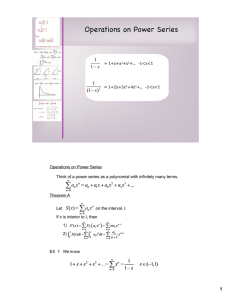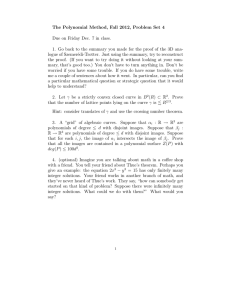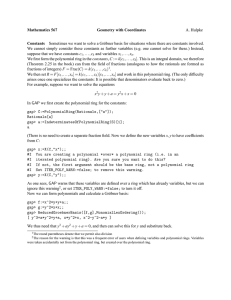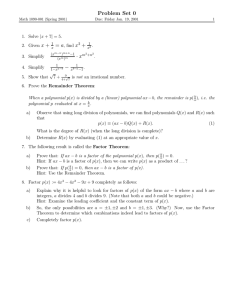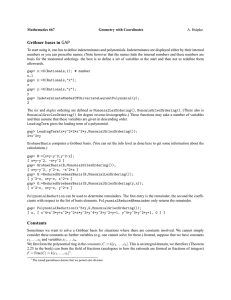Constants
advertisement
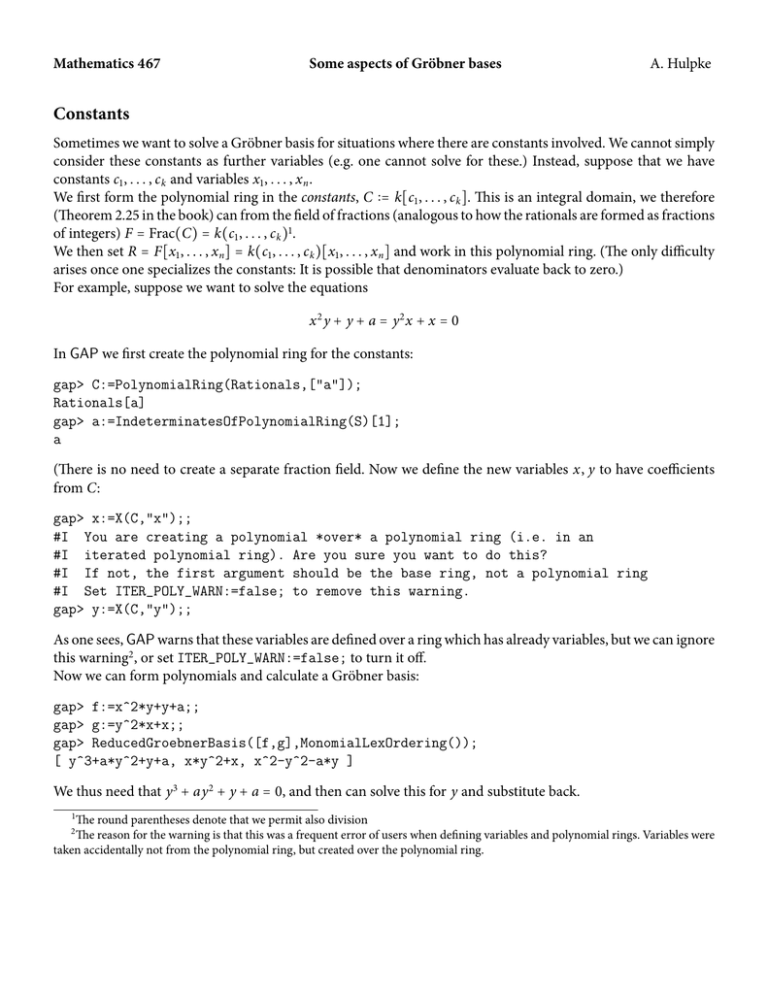
Mathematics 467
Some aspects of Gröbner bases
A. Hulpke
Constants
Sometimes we want to solve a Gröbner basis for situations where there are constants involved. We cannot simply
consider these constants as further variables (e.g. one cannot solve for these.) Instead, suppose that we have
constants c1 , . . . , c k and variables x1 , . . . , x n .
We first form the polynomial ring in the constants, C ∶= k[c1 , . . . , c k ]. This is an integral domain, we therefore
(Theorem 2.25 in the book) can from the field of fractions (analogous to how the rationals are formed as fractions
of integers) F = Frac(C) = k(c1 , . . . , c k )1 .
We then set R = F[x1 , . . . , x n ] = k(c1 , . . . , c k )[x1 , . . . , x n ] and work in this polynomial ring. (The only difficulty
arises once one specializes the constants: It is possible that denominators evaluate back to zero.)
For example, suppose we want to solve the equations
x 2 y + y + a = y2 x + x = 0
In GAP we first create the polynomial ring for the constants:
gap> C:=PolynomialRing(Rationals,["a"]);
Rationals[a]
gap> a:=IndeterminatesOfPolynomialRing(S)[1];
a
(There is no need to create a separate fraction field. Now we define the new variables x, y to have coefficients
from C:
gap> x:=X(C,"x");;
#I You are creating a polynomial *over* a polynomial ring (i.e. in an
#I iterated polynomial ring). Are you sure you want to do this?
#I If not, the first argument should be the base ring, not a polynomial ring
#I Set ITER_POLY_WARN:=false; to remove this warning.
gap> y:=X(C,"y");;
As one sees, GAP warns that these variables are defined over a ring which has already variables, but we can ignore
this warning2 , or set ITER_POLY_WARN:=false; to turn it off.
Now we can form polynomials and calculate a Gröbner basis:
gap> f:=x^2*y+y+a;;
gap> g:=y^2*x+x;;
gap> ReducedGroebnerBasis([f,g],MonomialLexOrdering());
[ y^3+a*y^2+y+a, x*y^2+x, x^2-y^2-a*y ]
We thus need that y 3 + ay 2 + y + a = 0, and then can solve this for y and substitute back.
1
The round parentheses denote that we permit also division
The reason for the warning is that this was a frequent error of users when defining variables and polynomial rings. Variables were
taken accidentally not from the polynomial ring, but created over the polynomial ring.
2
The Nullstellensatz and the Radical
In applications (see below) we sometimes want to check not whether g ∈ I ⊲ R, but whether g has “the same
roots” as I. (I.e. we want that g(x1 , . . . , x n ) = 0 if and only if f (x1 , . . . , x n ) = 0 for all f ∈ I.) Clearly this can hold
for polynomials not in I, for example consider I = ⟨x 2 ⟩ ⊲ Q[x], then g(x) = x ∈/ I, but has the same roots.
An important theorem from algebraic geometry show that over C, such a power condition is all that can happen3 :
Theorem (Hilbert’s Nullstellensatz): Let R = C[x1 , . . . , x n ] and I ⊲ R. If g ∈ R such that g(x1 , . . . , x n ) =
0 if and only if f (x1 , . . . , x n ) = 0 for all f ∈ I, then there exists an integer m, such that g m ∈ I.
The set {g ∈ R ∣ ∃m ∶ g m ∈ I} is called the Radical of I.
There is a neat way how one can test this property, without having to try out possible m: Suppose R = k[x1 , . . . , x n ]
and I = ⟨ f1 , . . . , f m ⟩ ⊲ R. Let g ∈ R. Then there exists a natural number m such that g m ∈ I if and only if (we
introduce an auxiliary variable y)
1 ∈ ⟨ f1 , . . . , f m , 1 − yg⟩ =∶ Ĩ ⊲ k[x1 , . . . , x n , y]
The reason is easy: If 1 ∈ Ĩ, we can write
1 = ∑ p(x1 , . . . , x n , y) ⋅ f i (x1 , . . . , x n ) + q(x1 , . . . , x n , y) ⋅ (1 − yg)
i
We now set y = 1/g (formally in the fraction field) and multiply with a sufficient high power (exponent m) of g,
to clean out all g in the denominators. We obtain
g m = ∑ g m ⋅ p(x1 , . . . , x n , 1/g m ) ⋅ f i (x1 , . . . , x n ) + g m ⋅ q(x1 , . . . , x n , y) ⋅ (1 − y/y) ∈ I.
i ´¹¹ ¹ ¹ ¹ ¹ ¹ ¹ ¹ ¹ ¹ ¹ ¹ ¹ ¹ ¹ ¹ ¹ ¹ ¹ ¹ ¹ ¹ ¹ ¹ ¹ ¹ ¹ ¹ ¹ ¹ ¹ ¹ ¸ ¹ ¹ ¹ ¹ ¹ ¹ ¹ ¹ ¹ ¹ ¹ ¹ ¹ ¹ ¹ ¹ ¹ ¹ ¹ ¹ ¹ ¹ ¹ ¹ ¹ ¹ ¹ ¹ ¹ ¹ ¹ ¹ ¹ ¶
´¹¹ ¹ ¹ ¹ ¹ ¹ ¹ ¹ ¹ ¹ ¹ ¹ ¹ ¹ ¹ ¹ ¹ ¹ ¹ ¹ ¹ ¹ ¹ ¹ ¹ ¹ ¹ ¹ ¹ ¹ ¹ ¹ ¹ ¹ ¹ ¹ ¹ ¹ ¹ ¹ ¹ ¹ ¹ ¹ ¹ ¹¸¹ ¹ ¹ ¹ ¹ ¹ ¹ ¹ ¹ ¹ ¹ ¹ ¹ ¹ ¹ ¹ ¹ ¹ ¹ ¹ ¹ ¹ ¹ ¹ ¹ ¹ ¹ ¹ ¹ ¹ ¹ ¹ ¹ ¹ ¹ ¹ ¹ ¹ ¹ ¹ ¹ ¹ ¹ ¹ ¹ ¹ ¹¶
=0
∈R
Vice versa, if g m ∈ I, then
1 = y m g m + (1 − y m g m ) = y m g m + (1 − yg)(1 + yg + ⋯ + y m−1 g m−1 ) ∈ Ĩ
² ´¹¹ ¹ ¹ ¹ ¹ ¸ ¹ ¹ ¹ ¹ ¹ ¶
∈I⊂Ĩ
∈Ĩ
This property can be tested easily, as 1 ∈ Ĩ ⇔ Ĩ = k[x1 , . . . , x n , y], which is the case only if a Gröbner basis for Ĩ
contains a constant.
We will see an application of this below.
Proving Theorems from Geometry
Suppose we describe points in the plane by their (x, y)-coordinates. We then can describe many geometric
properties by polynomial equations:
Theorem: Suppose that A = (x a , y a ), B = (xb , yb ), C = (x c , y c ) and D = (xd , yd ) are points in the plane. Then
the following geometric properties are described by polynomial equations:
AB is parallel to CD:
yb − y a yd − yc
=
, which implies (yb − y a )(xd − x c ) = (yd − y c )(xb − x a ).
xb − x a xd − xc
AB ⊥ CD: (xb − x a )(xd − x c ) + (yb − y a )(yd − y c ) = 0.
∣AB∣ = ∣CD∣: (xb − x a )2 + (yb − y a )2 = (xd − x c )2 + (yd − y c )2 .
C lies on the circle with center A though the point B: ∣AC∣ = ∣AB∣.
3
Actually, one does not need C, but only that the field is algebraically closed
1
C is the midpoint of AB: x c = (xb − x a ), y c = 21 (yb = y a ).
2
C is collinear with AB: self
BD bisects ∠ABC: self
A theorem from geometry now sets up as prerequisites some points (and their relation with circles and lines) and
claims (the conclusion) that this setup implies other conditions. If we suppose that (x i , y i ) are the coordinates of
all the points involved, the prerequisites thus are described by a set of polynomials f j ∈ Q[x1 , . . . , x n , y1 , . . . , y n ] =∶
R. A conclusion similarly corresponds to a polynomials g ∈ R.
The statement of the geometric theorem now says that whenever the {(x i , y i )} are points fulfilling the prerequisites (i.e. f j (x1 , . . . , x n , y1 , . . . , y n ) = 0), then also the conclusion holds for these points (i.e. g(x1 , . . . , x n , y1 , . . . , y n ) =
0).
This is exactly the condition we studied in the previous section and translated to g m ∈ ⟨ f1 , . . . , f m ⟩, which we can
test.
(Caveat: This is formally over C, but we typically want real coordinates. There is some extra subtlety in practice.)
For example, consider the theorem of Thales: Any triangle suspended under a half-circle has a right angle.
We assume (after rotation and scaling) that A = (−1, 0) and B = (1, 0) and
C
set C = (x, y) with variable coordinates. The fact that C is on the circle
(whose origin is (0, 0) and radius is 1) is specified by the polynomial
f = x 2 + y2 − 1 = 0
B
A
The right angle at C means that AC ⊥ BC. We encode this as
g = (x − (−1)) + (1 − x) + y(−y) = −x 2 − y 2 + 1 = 0.
Clearly g is implied by f .
Apollonius’ theorem
We want to use this approach to prove a classical geometrical theorem (it is a special case of the “Nine point” or
“Feuerbach circle” theorem):
Circle Theorem of Apollonius: Suppose that
ABC is a right angled triangle with right angle
at A. The midpoints of the three sides, and the
foot of the altitude drawn from A onto BC all lie
on a circle.
H
MBC
B
C
MAC
MAB
A
To translate this theorem into equations, we choose coordinates for the points A, B, C. For simplicity we set
(translation) A = (0, 0) and B = (b, 0) and C = (0, c), where b and c are constants. Suppose that M AB = (x1 , 0),
M AC = (0, x2 ) and M BC = (x3 , x4 ). We get the equations
f1
f2
f3
f4
=
=
=
=
2x1 − b = 0
2x2 − c = 0
2x3 − b = 0
2x4 − c = 0
Next assume that H = (x5 , x6 ). Then AH ⊥ BC yields
f5 = x5 b − x6 c = 0
Because H lies on BC, we get
f6 = x5 c + x6 b − bc = 0
To describe the circle, assume that the middle point is O = (x7 , x8 ). The circle property then means that ∣M AB O∣ =
∣M BC O∣ = ∣M AC O∣ which gives the conditions
f7 = (x1 − x7 )2 + (0 − x8 )2 − (x3 − x7 )2 − (x4 − x8 )2 = 0
f8 = (x1 − x7 )2 + x82 − x72 − (x8 − x2 )2 = 0
The conclusion is that ∣HO∣ = ∣M AB O∣, which translates to
g = (x5 − x7 )2 + (x6 − x8 )2 − (x1 − x7 )2 − x82 = 0.
We now want to show that there is an m, such that g m ∈ ⟨ f1 , . . . , f8 ⟩. In GAP, we first define a ring for the two
constants, and assign the constants. We also define variables over this ring.
R:=PolynomialRing(Rationals,["b","c"]);
ind:=IndeterminatesOfPolynomialRing(R);b:=ind[1];c:=ind[2];
x1:=X(R,"x1"); ... x8:=X(R,"x8");
We define the ideal generators f i as well as g:
f1:=2*x1-b;
f2:=2*x2-c;
f3:=2*x3-b;
f4:=2*x4-c;
f5:=x5*b-x6*c;
f6:=x5*c+x6*b-b*c;
f7:=(x1-x7)^2+(0-x8)^2-(x3-x7)^2-(x4-x8)^2;
f8:=(x1-x7)^2+x8^2-x7^2-(x8-x2)^2;
g:=(x5-x7)^2+(x6-x8)^2-(x1-x7)^2-x8^2;
For the test whether g m ∈ I, we need an auxiliary variable y. Then we can generate a Gröbner basis for Ĩ:
order:=MonomialLexOrdering();
bas:=ReducedGroebnerBasis([f1,f2,f3,f4,f5,f6,f7,f8,1-y*g],order);
The basis returned is (1), which means that indeed g m ∈ I.
If we wanted to know for which m, we can test membership in I itself, and find that already g ∈ I:
gap> bas:=ReducedGroebnerBasis([f1,f2,f3,f4,f5,f6,f7,f8],order);
[ x8-1/4*c, x7-1/4*b, x6+(-b^2*c/(b^2+c^2)), x5+(-b*c^2/(b^2+c^2)),
x4-1/2*c, x3-1/2*b, x2-1/2*c, x1-1/2*b ]
gap> PolynomialReducedRemainder(g,bas,order);
0

